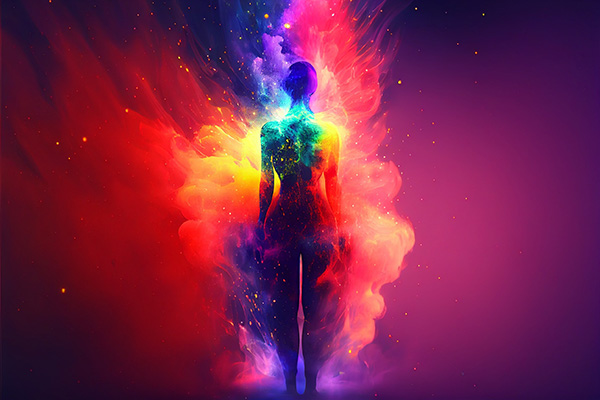Comprehending the Significance and Relevance of Colors in Spirituality
 Color saturates our lives, significantly influencing our living spaces, workplaces, our meals, and attire.
Color saturates our lives, significantly influencing our living spaces, workplaces, our meals, and attire.
In every aspect of our existence, color has a powerful impact, affecting our feelings, actions, and spiritual health.
In Kundalini Yoga, for instance, instructors typically don white garments made from natural materials, complemented by a white head scarf. This tradition serves more than just practical or visual purposes.
As the color white reflects sunlight while black absorbs it, white similarly repels negative energies, whereas black draws and retains them.
This tradition thus fulfills a dual function: it represents the purity and spiritual insight that the instructor embodies, while also shielding the instructor from negative energies potentially arising from students.
Kundalini Yoga attracts a diverse student base, ranging from those with advanced spiritual maturity to individuals dealing with emotional volatility. The white clothing functions as a barrier against negative energies that might be directed or “dumped” towards the teacher.
Specifically, the head covering safeguards the seventh chakra, found at the crown of the head. This chakra serves as our ‘spiritual umbilical cord’ linking us to God, Source, Spirit, or the Divine, making its protection vital.
It is also noteworthy that although black can be harmful in spiritual contexts due to its inclination to absorb negativity, it can be advantageous in physical activity. Dressing in black while exercising helps ground the body, instilling a sense of stability and concentration. This dual nature underscores the intricate symbolism of color and its diverse implications on our physical and spiritual conditions.
I think the names of colors linger at the threshold, where language falters and where it shines at its apex ~ A.S. Byatt
Chakra Colors In Everyday Speech
Did you realize that the energy frequencies of various chakra colors permeate our daily language? These metaphysical metaphors not only enrich our expression, but also provide glimpses into the deeper meanings and energetic ties of colors in our lives. Here are some of my preferred examples:
Root Chakra Red: “Seeing red” – This idiom conveys extreme rage or fury. The first, or root chakra, embodies red and signifies primal human aspects, including anger and physicality.
Sacral Chakra Orange: “Fired up” – This phrase implies enthusiasm, excitement, and high energy, consistent with the second chakra’s connections to creativity, passion, and emotional expression.
Solar Plexus Chakra Yellow: “Yellow-bellied” – Linked with cowardice or fragility, yellow represents the third chakra, which is associated with strength, determination, willpower, and drive.
Heart Chakra Green: “Green-eyed monster” – Representing jealousy and envy, green is tied to the lower fourth chakra, which regulates our love-related emotions and sense of balance.
Heart Chakra Pink: “Rose-colored glasses” – Someone who has a naively optimistic view of life. Pink, another color representing the higher fourth chakra, embodies love, joy, and compassion.
Throat Chakra Blue: “Feeling blue” – This idiom reflects sadness and unhappiness. Blue is associated with the fifth chakra, situated in the throat, which pertains to self-expression and honest communication. When we feel unable to express ourselves or find our thoughts and feelings stifled, it leads us to feel “‘blue.’”
Third Eye Chakra Indigo: “Deep as indigo” – This phrase denotes profound depth and enigma, aligning with the indigo hue’s association with the third eye chakra, the center of intuition, wisdom, and internal knowledge. Indigo embodies profound understanding and insight.
Crown Chakra Purple: “Born in the Purple” – This expression refers to an individual born into a royal or wealthy lineage, suggesting a life of luxury and significance. Purple signifies the seventh chakra, our energetic ‘crown’ connecting us to the divine and spiritual purity, similar to the elevated nature implied by being “born in the purple.”
Another striking example is the red, white, and blue of the American flag, symbolizing bravery (red), spiritual expression freedom (white), and communicative expression freedom (blue). These colors correspond to the first, seventh, and fifth chakras, showcasing the profound symbolic connections in cultural icons globally.
Similarly, traffic lights use red, yellow, and green to convey crucial notifications: red for stop (root chakra, fear and survival), yellow for caution (third chakra, gut instinct), and green for go (fourth chakra, peace and security). This association with the chakras underlines our intuitive responses to color signals in our surroundings.
Fast food establishments frequently utilize red, orange, and yellow in their decor. These colors, linked to the lower chakras, energize and stimulate appetite, prompting individuals to eat rapidly and more. The lower chakras relate to basic, physical, and masculine energies, invigorating in nature. In contrast, colors associated with the upper chakras – green, blue, purple, and white – are tranquil and soothing, fostering feelings of peace and relaxation.
All other colors are mere colors, but purple appears to possess a soul — when you gaze at it, it gazes back at you ~ Uniek Swain
Colors In Religion & Spirituality
Colors also carry profound symbolic meanings across numerous religious and spiritual practices, enriching rituals and enhancing adherents’ spiritual experiences. Here are five examples of color symbolism from different religious and spiritual frameworks:
Red in Hinduism: In Hinduism, red is an impactful color symbolizing purity, sensuality, and the divine feminine (Shakti). It frequently appears in religious events and festivals, like weddings and Durga Puja. Brides traditionally wear red saris, and red powder (kumkum) is applied to the forehead in various rituals, symbolizing auspiciousness and energy.
White in Buddhism: In Buddhism, white signifies purity, wisdom, and enlightenment. It is often linked with the Buddha and various deities like Avalokiteshvara, the Bodhisattva of Compassion, often depicted in white. Monks in some traditions don white robes during certain ceremonies, and white is used in funeral rites to represent the purity of the departed soul.
Green in Islam: Green holds great significance in Islam, symbolizing paradise, fertility, and life. The Quran mentions lush, green gardens in paradise, and green appears frequently in Islamic art and architecture. The dome of the Prophet Muhammad’s mosque in Medina is famously green and is also associated with the Prophet himself.
Blue in Judaism: In Judaism, blue symbolizes divinity, the heavens, and spirituality. The tallit (prayer shawl) often features blue stripes, and the tzitzit (fringes) contain a blue thread, known as tekhelet, as commanded in the Torah. Blue is also seen in the Star of David and is utilized during Hanukkah celebrations to symbolize divine protection and connection to God.
Purple in Christianity: Purple represents penance, humility, and royalty in Christianity. It is predominantly employed during the liturgical seasons of Advent and Lent. During these times, clergy wear purple vestments, and purple adorns church decorations, symbolizing a period of preparation and reflection. The color also signifies the royalty of Jesus Christ, acknowledging Him as the King of Kings. The use of purple encapsulates both the seriousness of repentance and the grandeur of Christ’s divine essence.
It’s crucial to recognize that color symbolism differs among religions and cultures. For instance, although red traditionally signifies purity and auspiciousness in Hinduism, it may bear negative implications in other contexts.
For example, in Taoist tradition, red is associated with positive attributes like good fortune and prosperity, yet it can also represent excessive or uncontrolled energy. Taoism emphasizes balance and harmony; thus, red, when employed excessively or inappropriately, may symbolize overactivity or aggression, disrupting the natural balance and flow of energy (chi). This nuanced perspective reflects the broader Taoist view that every element, including color, possesses both positive and negative potentials depending on its context and usage.
Grasping the significant influence of colors on our lives enables us to channel their power for our advantage. By consciously choosing the colors surrounding us, we can develop spaces and experiences fostering our physical, emotional, and spiritual well-being.
|
Satya resides in Northern California and is a natural Clairvoyant, Empath, Conduit, teacher, author, animal enthusiast, healer, Reiki Master, and an experienced yoga instructor. She has offered valuable psychic support to Hollywood stars, athletes, and every level of individual. A multi-faceted Intuitive, equipped with many distinct gifts, she provides a gateway into the past as well as a passage to a more joyful future. Through her long-distance energy work, she administers healing for both people and animals! She swiftly identifies karmic connections from past lives that directly affect contemporary situations, aiding clients in navigating through them effectively. For precise solutions to almost any urgent issue, you can connect with Satya at PsychicAccess.com. |
Understanding the Significance and Role of Colors in Spirituality
Colors have consistently been essential in human culture and spirituality. They can evoke feelings, influence our moods, and even affect our spiritual health. Within various spiritual traditions and belief systems, colors are given particular meanings and symbolism, deepening our comprehension of ourselves and our surrounding world. In this article, we will delve into the significance and role of colors in spirituality.
Red, symbolizing passion and energy, is frequently linked to vitality and strength. In numerous spiritual practices, red is thought to embody life force energy, also referred to as chi or prana. It’s seen as a potent color that can help spur courage, motivation, and determination. Red is often incorporated in meditations and rituals to stimulate and activate the root chakra, associated with grounding and survival instincts.
Orange, a vibrant and warm color, is commonly linked with creativity, enthusiasm, and joy. It’s thought to activate the sacral chakra, which governs emotions, sexuality, and relationships. Orange is often utilized in spiritual practices to boost creativity, self-confidence, and foster a sensation of abundance.
Yellow, associated with sunshine and happiness, signifies intellect, clarity, and optimism. It’s believed to stimulate the solar plexus chakra, linked to personal power and self-esteem. Yellow is frequently utilized in spiritual practices to enhance mental clarity, improve decision-making, and endorse a positive life outlook.
Green, the hue of nature and healing, is associated with balance, harmony, and growth. It’s presumed to activate the heart chakra, which governs our ability to love and connect with others. Green plays a role in spiritual practices to promote emotional healing, empathy, and a strong bond with nature.
Blue, representing the sky and ocean, conveys calmness, tranquility, and communication. It’s thought to activate the throat chakra, which governs our ability to express and communicate our truth. Blue is often utilized in spiritual practices to enhance clear communication, intuition, and deep relaxation.
Purple, a color linked to spirituality and mysticism, relates to wisdom, spirituality, and higher consciousness. It’s considered to stimulate the third eye chakra, which oversees our intuition and spiritual insight. Purple is often present in spiritual practices to bolster psychic abilities, deepen meditation, and forge connections with the divine.
White, representing purity and light, denotes clarity, spirituality, and transcendence. It is frequently used in spiritual practices to symbolize purification, healing, and spiritual awakening. White signifies the pinnacle of consciousness and is typically linked with divine entities and spiritual guides.
Understanding colors’ significance and importance in spirituality can empower us to wield their energy and symbolism to enhance our spiritual journeys. By incorporating specific colors into our meditations, rituals, and daily practices, we align ourselves with the qualities and energies each color represents.
It’s vital to acknowledge that personal interpretations of colors may vary considerably across spiritual beliefs and cultures. Thus, it’s essential to investigate and comprehend the specific meanings and symbolism each color carries within your spiritual practice or belief system.
In summary, colors hold immense significance in spirituality, influencing our emotions, energy levels, and spiritual well-being. By recognizing the meanings and symbolism tied to different colors, we can leverage their power to enrich our spiritual journeys, foster healing, and connect with the divine. So, the next time you encounter a specific color, take a moment to consider its spiritual meaning and how it may be guiding your path. Continue reading





